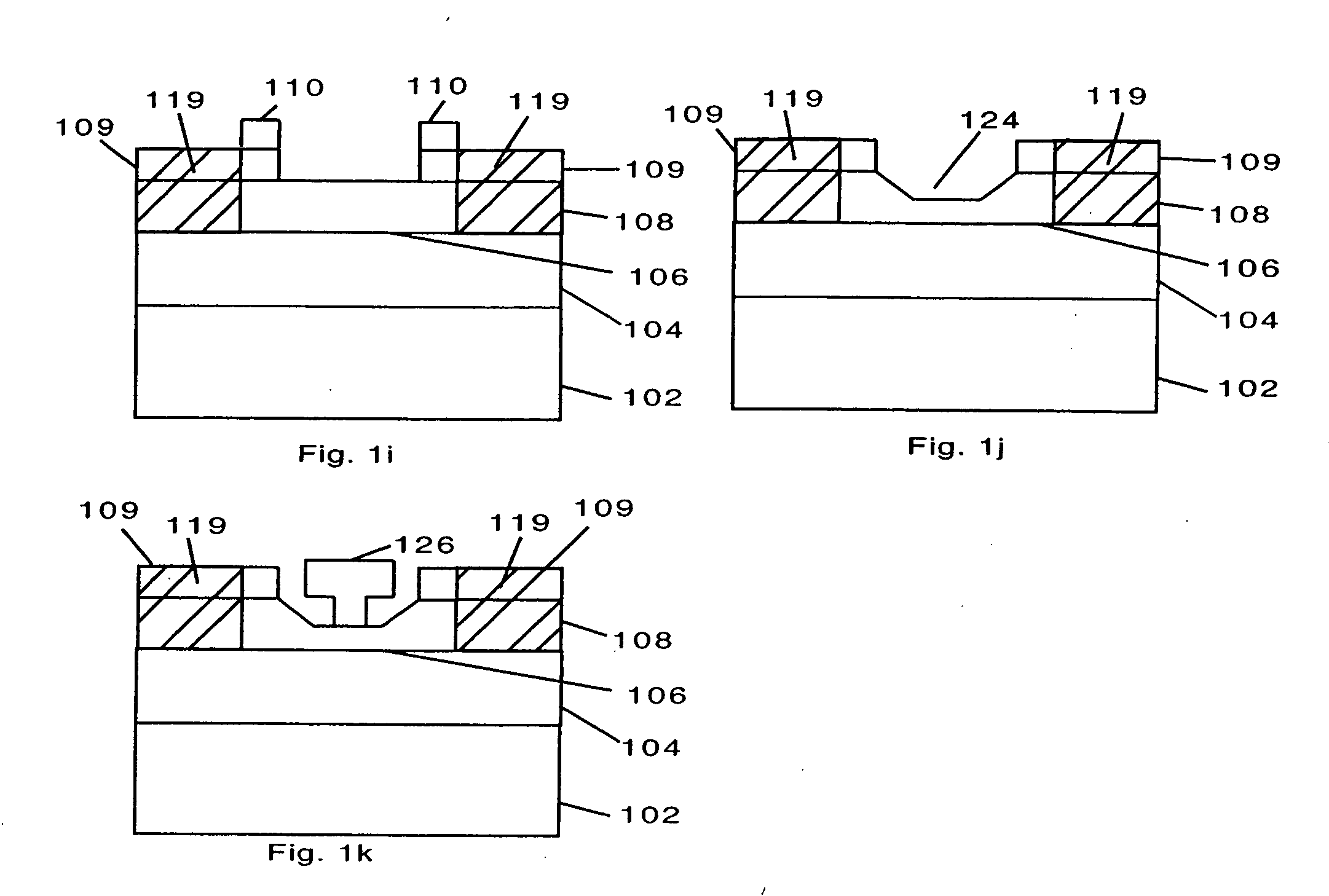Method for fabricating a non-planar nitride-based heterostructure field effect transistor
a heterostructure field effect transistor and nitride-based technology, applied in the direction of semiconductor devices, electrical equipment, basic electric elements, etc., can solve the problems that have not been attainable using gan or other group iii-nitride materials to fabricate non-planar regions, and achieve predictable and repeatable results without reducing the performance of the transistor, prevent oxidation, and prevent damage to the layer of semiconductor materials
- Summary
- Abstract
- Description
- Claims
- Application Information
AI Technical Summary
Benefits of technology
Problems solved by technology
Method used
Image
Examples
first embodiment
[0050] A method useful for fabricating a non-planar nitride-based heterostructure field effect transistor according to a first embodiment of the present invention is described with reference to FIGS. 1a-1k. In this first embodiment, a substrate 102 is provided as shown in FIG. 1a. The substrate 102 preferably comprises sapphire, silicon carbide, or GaN. Next, a first layer 104 is provided as shown in FIG. 1b. The first layer 104 is deposited, preferably epitaxially, on the substrate 102. The first layer 104 preferably comprises GaN, however other materials such as InP or InGaN can be used as well. Next, an AlN layer 108 is provided as shown in FIG. 1c. The AlN layer 108 is preferably deposited epitaxially on the first layer 104. The AlN layer 108 has a thickness of preferably not more than 10 nm. When the AlN layer 108 is deposited on the first layer 104, an interface 106 is created as shown in FIG. 1c. The interface 106 serves as the channel of the transistor, which will be discuss...
second embodiment
[0055] A method for fabricating a non-planar heterostructure field effect transistor according to a second embodiment of the present invention is described with reference to FIGS. 2a-2m. In this embodiment a substrate 202 as shown in FIG. 2a is provided. The substrate 202 preferably comprises sapphire, silicon carbide, or GaN. A first layer 204 is deposited, preferably epitaxially, on the substrate 202 as shown in FIG. 2b. The first layer 204 preferably comprises GaN, however other materials such as InN or InGaN can be used as well. A second layer 206 is deposited, preferably epitaxially, on the first layer 204. The second layer 206, as shown in FIG. 2c, preferably comprises AlGaN. By depositing the second layer 206 on top of the first layer 204, an interface 208 is created. The interface 208 is located where the first layer 204 contacts the second layer 206 and is further discussed later. A third layer 210 is deposited, preferably epitaxially, on the surface of the second layer 206...
third embodiment
[0061] A method for fabricating a non-planar heterostructure field effect transistor according to a third embodiment is described with reference to FIGS. 3a-3l. In this embodiment, a substrate 302 is provided as shown in FIG. 3a. The substrate 302 preferably comprises sapphire, silicon carbide, or GaN. Next, a first layer 304 preferably comprising GaN is provided as shown in FIG. 3b, however, other materials such as InN or InGaN could work equally as well. The first layer 304 is deposited, preferably epitaxially, on the substrate 302. A second layer 306 is provided as shown in FIG. 3c. The second layer 306 preferably comprises AlGaN and is deposited, preferably epitaxially, on the first layer 304. By depositing the second layer 306 on the first layer 304, an interface 305 is created. The interface 305 is located where the first layer 304 contacts the second layer 306 and is further discussed later. Next, an AlN layer 308 is deposited, preferably epitaxially on the second layer 306 a...
PUM
 Login to View More
Login to View More Abstract
Description
Claims
Application Information
 Login to View More
Login to View More - R&D
- Intellectual Property
- Life Sciences
- Materials
- Tech Scout
- Unparalleled Data Quality
- Higher Quality Content
- 60% Fewer Hallucinations
Browse by: Latest US Patents, China's latest patents, Technical Efficacy Thesaurus, Application Domain, Technology Topic, Popular Technical Reports.
© 2025 PatSnap. All rights reserved.Legal|Privacy policy|Modern Slavery Act Transparency Statement|Sitemap|About US| Contact US: help@patsnap.com



